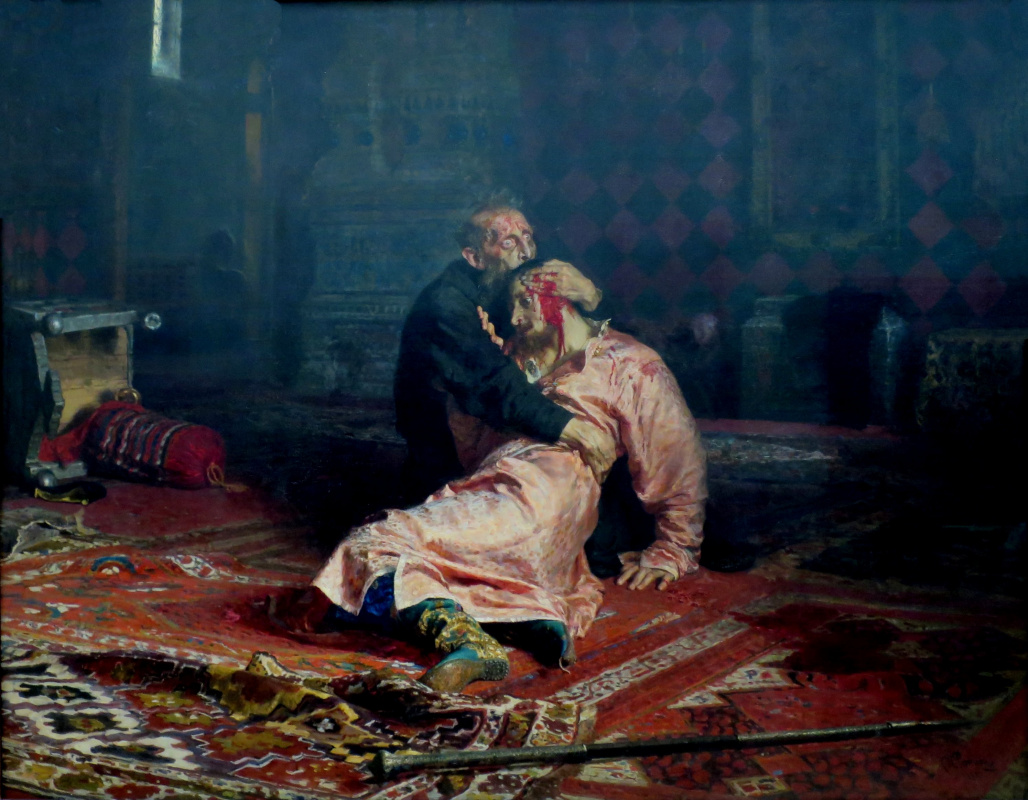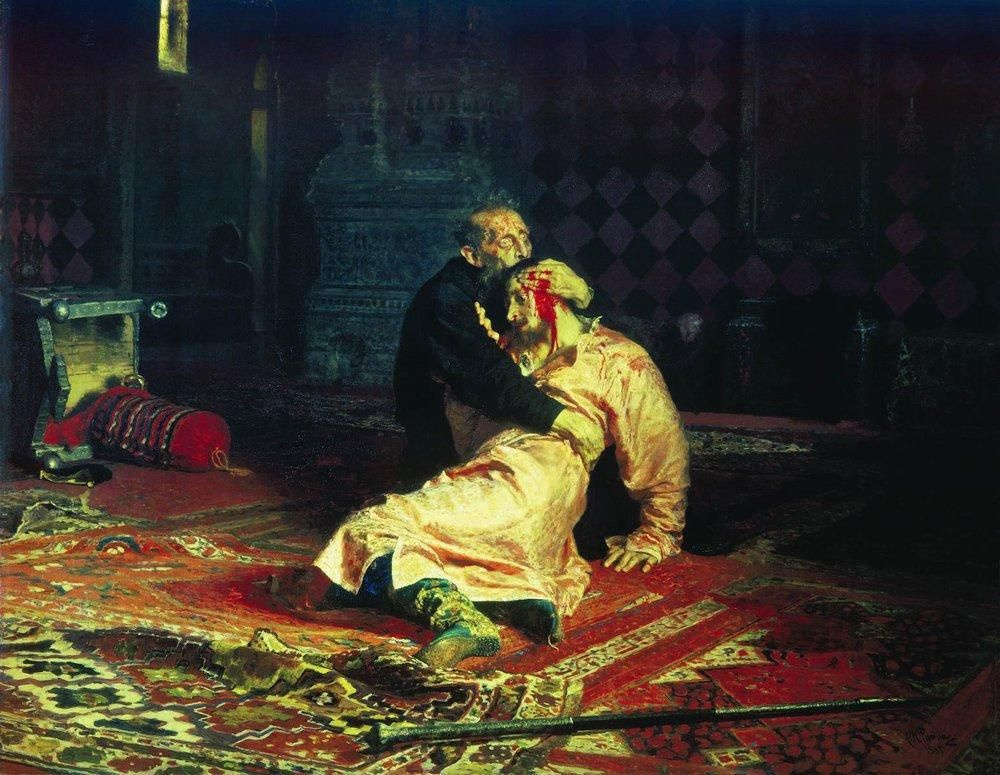log in
Enter site
Login to use Arthive functionality to the maximum
Ivan the terrible and his son Ivan on 16 November 1581
Ilya Efimovich Repin • Painting, 1885, 199.5×254 cm
Description of the artwork «Ivan the terrible and his son Ivan on 16 November 1581»
Repin's painting, showing how Ivan the terrible kills his son, was exhibited at the XIII exhibition of the Wanderers. Excited audience literally observed the exhibition building, near which all day on duty, a detachment of gendarmes "just in case". Further history revealed that the "event" will take place.
The plot of the famous episode from the life of Czar Ivan the terrible. In a fit of anger he killed his son. The name specified is the exact date of the incident. This saw the reference to another exact date of our time, the murder happened 300 years later. On March 1, 1881 members of the Narodnaya Volya killed Tsar Alexander II, this was followed by their execution. These are historical events that pushed the Repin painting. There was another incentive, less well-known. In 1883, Repin traveled to Europe in Spain and watched a bullfight. He was struck by this bloody attraction: "Misery, living death, murder and blood are ... which involve him the power..."– confessed to the artist. When he returned, he began to write a very bloody scene with Ivan the Terrible and his son.
If the majority of the paintings Repin worked in his Studio, for the creation of this specially equipped separate room. Moreover, he created patterns for costumes. Ivan the terrible he saw in the way accidentally met in the market laborer, and the role of the king's son posed for Vsevolod Garshin – it is Repin depicted in the image returned from the exile of the revolutionary in the picture "Unexpected".
As in the work before us is again the time of maximum intensity of the feelings, but the feelings are completely different plan. We see a gloomy chamber, with red carpets. Left – inverted in the struggle of the throne, beside the dying Prince was lying abandoned wand – Ivan the terrible just smashed the head of his son. In the center of the illuminated two figures. Ivan the terrible holding his son in his dilated eyes – the horror, despair and madness. The face of the Prince almost iconographic. It is humility, forgiveness, parents and endless love. From his temple hlyschet blood, the father attempts to stop the flow hopeless.
Work on the picture has been hard. The artist admitted: "The minute I was getting scared. I turned away from this picture, hid it. My friends, it has produced the same impression. But something drove me to this picture, and I again worked on it". It was terrible not only to him. "Ivan the terrible and his son Ivan November 16, 1581" for the first time in the Russian Empire, formally subjected to the highest censorship. Emperor Alexander III personally banned her to the show. Collector Pavel Tretyakov immediately appreciated masterpiece and bought the painting, but kept her in a separate room and were not allowed to exhibit. Three months later, thanks to the intercession of the approximate to the Emperor of the artist Alexey Bogolyubov the ban was lifted.
And on January 16, 1913, the old believers, Ivan Balashov was so impressed with the painting by Repin that... slashed the painting with a knife Shoe. Shouting "enough death, enough blood!" 28-year-old painter jumped over the barrier and before he had time to stop, three times slashed the canvas with a knife.
The Titanic efforts of the Repin and Bogolyubov painting was restored. Balashov was recognised as mentally ill. Another dark spot in the history of "Ivan the Terrible" – the Keeper of the Tretyakov gallery Georgy Khruslov after this incident committed suicide. Rumor attributes the suicide to the shock of vandalism, but documentary evidence of this version does not. Khruslov just excused myself for half an hour and not leaving any notes and suicide notes, in Sokolniki jumped under a train.
One hundred years later, in 2013, a group of Orthodox activists created a petition calling to remove the painting from the Tretyakov gallery, because it "it offends the Patriotic feelings of the Russian people". To protect the fabric rose, then Director of the Tretyakov gallery Irina Lebedeva, she was able to defend the painting, she remained in the permanent exhibition of the Tretyakov gallery. And today we can stand in this controversial masterpiece of Repin, unable to take his eyes off him and feeling the chilling horror of the bloody scenes of infanticide.
Author: Alain Esaulova
The plot of the famous episode from the life of Czar Ivan the terrible. In a fit of anger he killed his son. The name specified is the exact date of the incident. This saw the reference to another exact date of our time, the murder happened 300 years later. On March 1, 1881 members of the Narodnaya Volya killed Tsar Alexander II, this was followed by their execution. These are historical events that pushed the Repin painting. There was another incentive, less well-known. In 1883, Repin traveled to Europe in Spain and watched a bullfight. He was struck by this bloody attraction: "Misery, living death, murder and blood are ... which involve him the power..."– confessed to the artist. When he returned, he began to write a very bloody scene with Ivan the Terrible and his son.
If the majority of the paintings Repin worked in his Studio, for the creation of this specially equipped separate room. Moreover, he created patterns for costumes. Ivan the terrible he saw in the way accidentally met in the market laborer, and the role of the king's son posed for Vsevolod Garshin – it is Repin depicted in the image returned from the exile of the revolutionary in the picture "Unexpected".
As in the work before us is again the time of maximum intensity of the feelings, but the feelings are completely different plan. We see a gloomy chamber, with red carpets. Left – inverted in the struggle of the throne, beside the dying Prince was lying abandoned wand – Ivan the terrible just smashed the head of his son. In the center of the illuminated two figures. Ivan the terrible holding his son in his dilated eyes – the horror, despair and madness. The face of the Prince almost iconographic. It is humility, forgiveness, parents and endless love. From his temple hlyschet blood, the father attempts to stop the flow hopeless.
Work on the picture has been hard. The artist admitted: "The minute I was getting scared. I turned away from this picture, hid it. My friends, it has produced the same impression. But something drove me to this picture, and I again worked on it". It was terrible not only to him. "Ivan the terrible and his son Ivan November 16, 1581" for the first time in the Russian Empire, formally subjected to the highest censorship. Emperor Alexander III personally banned her to the show. Collector Pavel Tretyakov immediately appreciated masterpiece and bought the painting, but kept her in a separate room and were not allowed to exhibit. Three months later, thanks to the intercession of the approximate to the Emperor of the artist Alexey Bogolyubov the ban was lifted.
And on January 16, 1913, the old believers, Ivan Balashov was so impressed with the painting by Repin that... slashed the painting with a knife Shoe. Shouting "enough death, enough blood!" 28-year-old painter jumped over the barrier and before he had time to stop, three times slashed the canvas with a knife.
The Titanic efforts of the Repin and Bogolyubov painting was restored. Balashov was recognised as mentally ill. Another dark spot in the history of "Ivan the Terrible" – the Keeper of the Tretyakov gallery Georgy Khruslov after this incident committed suicide. Rumor attributes the suicide to the shock of vandalism, but documentary evidence of this version does not. Khruslov just excused myself for half an hour and not leaving any notes and suicide notes, in Sokolniki jumped under a train.
One hundred years later, in 2013, a group of Orthodox activists created a petition calling to remove the painting from the Tretyakov gallery, because it "it offends the Patriotic feelings of the Russian people". To protect the fabric rose, then Director of the Tretyakov gallery Irina Lebedeva, she was able to defend the painting, she remained in the permanent exhibition of the Tretyakov gallery. And today we can stand in this controversial masterpiece of Repin, unable to take his eyes off him and feeling the chilling horror of the bloody scenes of infanticide.
Author: Alain Esaulova








